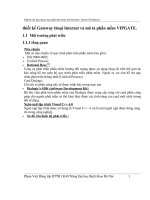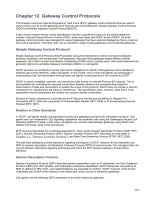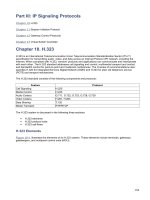Gateway Control Protocols
Bạn đang xem bản rút gọn của tài liệu. Xem và tải ngay bản đầy đủ của tài liệu tại đây (301.39 KB, 14 trang )
Chapter 12. Gateway Control Protocols
This chapter covers two Internet Engineering Task Force (IETF) gateway control protocols that are used to
control Voice over IP (VoIP) gateways from external call-control elements: Simple Gateway Control Protocol
(SGCP) and Media Gateway Control Protocol (MGCP).
It also covers another device control specification that has a significant impact on the packet telephony
industry: Internet Protocol Device Control (IPDC), which was fused with SGCP to form MGCP. All three
gateway control protocols were designed to support gateways that have external intelligence (that is, external
call-control elements). Therefore, their use is prevalent in large trunking gateways and residential gateways.
Simple Gateway Control Protocol
Simple Gateway Control Protocol (SGCP) enables call-control elements to control connections between
trunking, residential, and access-type VoIP gateways. Although these gateways target different market
segments, all of them convert time-division multiplexing (TDM) voice to packet voice. Call-control elements are
generally referred to as Media Gateway Controllers (MGCs) or call agents.
SGCP assumes an architecture whose call-control intelligence is outside of the gateway and is handled by
external call-control elements, called call agents. In this model, one or more call agents can participate in
constructing a call. Synchronization among these call agents is assumed and is not covered by SGCP.
SGCP is used to establish, maintain, and disconnect calls across an Internet Protocol (IP) network. This is
accomplished by controlling the required connections between desired and corresponding endpoints.
Authorization of calls and connections is outside the scope of this protocol. SGCP does not contain a security
mechanism for unauthorized call setup or interference. The specification does, however, state that it is the
expectation that all transactions are carried over secure Internet connections.
Security for these connections is provided by the IP Security Architecture as defined in Request For
Comments (RFC) 1825 and using either IP Authentication Header (RFC 1826) or IP Encapsulating Security
Payload (RFC 1827).
Relation to Other Standards
In SGCP, call agents handle call signaling functions and gateways provide audio translation functions. Call
agents also can implement H.323 signaling capabilities and establish calls using the Gatekeeper Routed Call
Signaling (GKRCS) model. In this case, call agents can connect calls between gateways using SGCP and
between terminals using H.323 procedures.
IETF produced standards for multimedia applications. They include Session Description Protocol (SDP; RFC
2327), Service Advertising Protocol (SAP), Session Initiation Protocol (SIP, discussed in more detail in
Chapter 11, "Session Initiation Protocol"
), and Real-Time Streaming Protocol (RTSP; RFC 2326).
The last three standards provide alternative signaling techniques to SGCP, however all four standards use
SDP for session description and Real-time Transport Protocol (RTP) to transmit audio. The call agent also can
convert between alternative signaling techniques and direct the RTP streams between corresponding
elements.
Session Description Protocol
Session Description Protocol (SDP) describes session parameters such as IP addresses, the User Datagram
Protocol (UDP) port, RTP profiles, and multimedia conference capabilities. SGCP follows the conventions of
SDP as defined in RFC 2327, and implementations are expected to conform. SGCP, however, limits its first
multimedia use of SDP to the setting of one media type: audio circuits in telephony gateways.
Call agents use the following SDP parameters to provision telephony gateways:
187
• IP Addresses—Specify remote gateway, local gateway, or multicast audio conference addresses used
to exchange RTP packets
• UDP Port—Indicates the transport port used to receive RTP packets from the remote gateway
• Audio Media—Specify audio media, including codec
Transmission over UDP
SGCP's request messages are sent to IP addresses of specified endpoints using UDP. Response messages
also are sent through UDP back to the originator's source IP address. UDP provides connectionless service
over IP and, therefore, might be subjected to packet losses. SGCP handles lost or delayed responses by
repeating requests. To accomplish these requests, SGCP entities are expected to maintain a list of currently
executing transactions as well as all responses sent within the last 30 seconds.
This list enables the entity to compare the transaction identifier of incoming requests to transaction identifiers
of the latest responses. Therefore, if an entity receives a request with a transaction identifier matching one of
the cached responses, it resends the response. The onus is on the requesting entity to provide suitable
timeouts, provide timely retries, clear pending connections, and seek redundant services.
SGCP Concepts
The basic constructs of SGCP are endpoints and connections. Groups of connections constitute a call, which
is set up by one or more call agents. Another key concept covered in this section is the use of digit maps for
collecting digits at gateways.
Endpoints
Endpoints are sources or sinks of data that physically or logically exist within an entity. Trunk circuits
connecting gateways and telephone switches are physical endpoints, whereas announcements stored in audio
devices are logical endpoints. Endpoints are identified by two components: the domain name of the entity
where the endpoint exists, and the local name specifying the individual endpoint.
In the case of trunk circuits, call agents have Signaling System 7 (SS7) interconnection where circuits are
identified by trunk group and circuit number. Therefore, when the call agent is creating a connection, the
following identifies the endpoint:
domain name / interface / circuit number
The domain name and the interface represent the gateway and link where the endpoint exists. The circuit
represents the physical digital signal level 0 (DS-0) where the call is terminated.
Connections
Connections exist in either point-to-point or multipoint form. You use several point-to-point connections to
construct a call and to transfer data between endpoints. Multipoint connections connect an endpoint to a
multipoint session. The gateway identifies the connection when instructed to create a connection. These
connection identifiers represent the connection between the endpoint and the call.
Calls
A group of connections compose a call. Call agents assign call identifiers, which are unique for each call and
are globally unique throughout the system. A unique call identifier links all connections associated with a call.
This identifier enables accounting or billing mediation to occur for SGCP-based calls.
Call Agents
Call agents are external elements providing call-control intelligence for VoIP networks. Call agents are
identified within the network by their domain name, not by their IP address. Domain name service enables
redundant call-agent implementations and platform changes to occur without disrupting service.
188
Digit Maps
Access gateways use digit maps to send the entire number a user dials to the call agent. The call agent uses
these digit maps to instruct the gateway to collect the dialed digits. You also can use digit maps with trunking
gateways (TGWs) to collect access codes and credit card numbers. Digit maps are considered a set of dial-
plan rules for the gateway to use to collect the proper digits so that the call agent can make a routing decision.
Digit maps tell the gateway when to stop collecting digits and transmit the number. Table 12-1
depicts
different dialed sequences that an access gateway must buffer as well as know when to transmit.
Table 12-1. Dialed Number and Services
Number Dialed Service
0 U.S. local operator services
411 U.S. directory services
911 U.S. emergency services
1 + up to 10 digits U.S. long-distance number
011 + up to 14 digits U.S. international number
Control Functions
SGCP service consists of endpoint-handling and connection-handling functions. SGCP service enables the
call agent to instruct the gateway on connection creation, modification, and deletion and informs the call agent
about events occurring in the gateway. The SGCP protocol has the following five primitives or commands (also
known as verbs):
• NoficationRequest—
Call agents issue this command to instruct gateways to detect events such as off-hook and Dual-Tone
Multi-Frequency (DTMF) tones.
• Notify—
Gateways use this command to advise the call agent of events.
• CreateConnection—
Call agents use this command to create endpoint connections within a gateway.
• ModifyConnection—
Call agents issue this request to change established connection parameters. You can use this
command to change the RTP audio path egress gateway to a different egress gateway, for example.
• DeleteConnection—
Call agents and gateways use this command to disconnect existing connections.
These five functions control gateways and inform call agents about events. Each command or request
contains specific parameters required to execute the transaction. Table 12-2
provides the Mandatory (M),
Optional (O), and Forbidden (F) parameters for each request.
189
Table 12-2. SGCP Request Parameters
Parameter NotificationRequest Notify CreateConnection ModifyConnection DeleteConnection
Call Identifier M M O F F
Connection Identifier F M O F F
Request Identifier O O O M M
Local Connection
Options
O M F F F
Connection Mode M M F F F
Requested Events O O O O F
Signal Request O O O O F
Notified Entity O O O O O
Observed Event F F F F M
Digit Map O O O O F
Reason Code F F O F F
Connection
Parameters
F F O F F
Specified Endpoint
ID
F F F F F
This is a good place to cover the concept of connection modes before delving deeper into each request
function. A mode parameter determines and qualifies how to handle audio received on connections. The
connection's operation is described by the connection modes illustrated in Table 12-3
.
Table 12-3. Connection Modes
Mode Operation
sendonly Gateway should only send packets.
recvonly Gateway should only receive packets.
sendrecv Gateway should send and receive packets.
inactive Gateway should not send or receive packets.
loopback Gateway should place circuit in loopback mode.
conttest Gateway should place circuit in test mode.
NotificationRequest
The NotificationRequest command advises the gateway to notify the originator when a specified event occurs
in an endpoint. The call agent downloads a list of events to the gateway that's requesting the detection and
reporting certain events. The notification request typically contains the following fields:
• Endpoint ID—Indicates the endpoint in the gateway where the request executes.
• Notified Entity—If present, specifies where notification should be sent. If not present, indicates that
notification should be sent to the originator.
• Request Identifier—Correlates request to notification that is triggered.
• Digit Map—Enables the call agent to download a digit map that only returns digits for subsequent
notifications. An optional parameter.
• Requested Events—Contains the list of events the gateway is requested to detect and report on to the
call agent. Possible events in the list include fax and modem tones, continuity tone and detection, on-
hook and off-hook transition, flash hook, channel-associated signaling (CAS), wink, and DTMF or
pulse digits. In addition, each event has an associated action such as "notify the event immediately,"
"swap audio for call waiting and three-way calling," "accumulate according to digit map," and "ignore
the event."
• Signal Requests—Specifies a set of endpoint actions that the gateway is requested to perform. The
list of actions includes ringing and distinctive ringing, as well as ring back, dial, intercept, busy,
answer, call waiting, off-hook warning, and continuity tones.
190
The requested event refers to the detection of an event, and the signal event refers to the resulting action. If
off-hook is the requested event, for example, dial tone is the signal event.
Notification
The gateway sends a Notification based on requested events in the notification request and on the occurrence
of these observed events. The Notification command contains the following parameters:
• Endpoint ID—This parameter indicates the endpoint in the gateway that is issuing the notification.
• Notified Entity—This optional parameter is equal to the same parameter in the corresponding
notification request.
• Requested Identifier—This parameter is equal to the same parameter in the notification request and
correlates the request to the notification.
• Observer Events—This parameter contains the actual observed data based on the requested event
parameter in the notification request.
CreateConnection
As its name indicates, this function creates a connection between two endpoints. The following
CreateConnection parameters provide the necessary information to build a gateway's view of a connection:
• Call ID—All connections related to a call share this network-wide or global unique identifier.
• Endpoint ID—Identifies the endpoint in the gateway where the CreateConnection command is
executed.
• Notified Entity—Optional parameter specifying where notifications should be sent.
• Local Connection Options—Describes data communication characteristics used to execute the
CreateConnection command. The fields in this parameter include encoding method, packetization
period, bandwidth, type of service (ToS), and use of echo cancellation. By default, echo cancellation is
always performed; however, this field enables these operations to be turned off.
• Mode—Dictates the mode of operation for the connection. The options are full duplex, receive only,
send only, inactive, and loopback.
• Remote Connection Descriptor—Indicates the local connection options sent to the remote gateway.
• Requested Events, Request Identifier, Digit Map, Signal Requests—The call agent can use these
optional parameters to transmit a notification request that can be executed as a connection is created.
ModifyConnection
The ModifyConnection function changes the characteristics of the gateway's view of a connection or call. The
parameters and fields in ModifyConnection are the same as those in the CreateConnection request, with the
addition of the Connection ID parameter. The Connection ID parameter uniquely identifies the connections
within a call. You can change the following connection parameters by changing the mode parameter of the
ModifyConnection command: encoding scheme, packetization period, echo cancellation, and activate or
deactivate connections.
DeleteConnection
A call agent or a gateway issues the DeleteConnection function to terminate a connection. Call agents use this
request to terminate a connection between two endpoints or to clear all connections that terminate on a given
endpoint. The gateway issues this command to clear connections if it detects that an endpoint is no longer
able to send or receive audio. If the gateway clears a connection, a reason code is included in the message
indicating the cause.
After connections are terminated, gateways should place the endpoint into inactive mode, thus making it
available for a subsequent session. A valuable attribute of the DeleteConnection command is that it distributes
statistics regarding a call. The statistical data contained in the DeleteConnection message is listed in Table
12-4.
191









